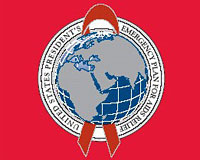| Blood Safety (Updated February 2008) PDF version PDF version
 |
President George W. Bush's
Emergency Plan for AIDS
Relief is the largest commitment
ever by any nation for an
international health
initiative dedicated to
a single disease-- a
five-year, $15 billion,
comprehensive approach to
combating the disease
around the world.
U.S. Department of
State
U.S. Agency for
International
Development
U.S. Department of
Defense
U.S. Department of
Commerce
U.S. Department of
Labor
U.S. Department of
Health and Human
Services
Peace Corps
Mailing address:
SA-29, 2nd Floor
2201 C Street, NW
Washington, DC 20522-2920
www.PEPFAR.gov
| |

Blood Safety
Unsafe blood transfusions can lead to HIV infection. In developing countries, the risk of contracting HIV from a blood transfusion is magnified by weak health care infrastructures and inadequate supplies of safe blood. Women and children are at greatest risk, due to the frequent use of blood transfusions to treat complications during pregnancy, childhood anemia associated with malaria, and various trauma incidents.
The U.S. President’s Emergency Plan for AIDS Relief (Emergency Plan/PEPFAR) supports programs to reduce the threat of transfusion-associated HIV infection, as well as programs to train health care workers in universal medical precautions. It also supports programs to improve the quality of blood supplies through improved policies, infrastructure, commodity procurement and management.
|
The Power of Partnerships:
In fiscal year 2007, the Emergency Plan supported:
- Approximately 4,589 blood safety service outlets or programs including blood collection centers, blood banks, laboratories and hospitals.
- Training or retraining for approximately 7,558 people in blood safety.
|
Since fiscal year 2004, National Blood Transfusion Services in 14 countries have received a total of $107.01 million under the Emergency Plan to support blood safety initiatives. Priorities include:
- Support for infrastructure, with a focus on laboratory development;
- Technical assistance to improve blood collection procedures and policies, including support for strategies to recruit and retain low-risk voluntary, non-remunerated blood donors, and to facilitate access to HIV/AIDS treatment and care programs for those who seek to donate blood but are revealed by testing to be HIV-positive;
- Support for universal testing of blood units for HIV and other transfusion-transmissible infections;
- Education for physicians and other clinicians in transfusion practices and utilization guidelines to reduce inappropriate use of blood as a clinical therapy, which has been linked to shortages;
- Training for laboratory and clinical staff in all aspects of blood collection, storage, testing and utilization; and
- Support for monitoring and evaluation practices. Data derived from this activity can be used by countries to develop or update strategic plans and identify strategies to ensure long-term sustainability.
|
|

The Emergency Plan blood safety initiative is designed to provide tailored support to countries as they develop or strengthen national policies and guidelines on blood safety that address their own country-specific issues. In addition, the Emergency Plan strengthens laboratory screening practices to test blood not only for HIV, but also for other transfusion-transmissible infections, including hepatitis B and C and syphilis. The Emergency Plan also supports technical assistance to supplement existing capacity and contribute to the professional development of national blood service staff at all levels.
The Emergency Plan at Work:
The following examples illustrate how the Emergency Plan is working under national strategies and in partnership with host nations to ensure a safe blood supply:
- In Tanzania, the National Blood Transfusion Service (NBTS) completed the expansion of a network of regional blood collection and transfusion centers.
- In Côte d’Ivoire, the Emergency Plan supported internal evaluations of blood usage to chart increased demand for blood during the malaria season. Data from this evaluation were used to change collection methods during the rainy season to increase the availability of pediatric-sized blood bags for pediatric cases of malaria-associated anemia.
- In Kenya, blood donations from volunteer donors nearly tripled in two years, from 43,000 units to 117,482 units. The NBTS now supplies 125 healthcare facilities with at least 80 percent of their blood needs, up from only eight sites in 2004.
- In Rwanda, the NBTS instituted a cross-cutting incentive system to attract and retain voluntary, non-remunerated blood donors. Repeat donors qualify for a series of awards, including insecticide-treated bed nets to combat malaria and bicycles to facilitate access to health services and work. This integration of blood donor retention strategies with broader public health activities is a model the Emergency Plan seeks to replicate in other countries.
- In Zambia, financial and technical support has enhanced cooperation and efficiencies within the national network of blood service sites. By using regional blood centers for donor recruitment and blood collection, as well as testing and distribution, hospital-based blood banks can focus on storing screened blood, cross-matching blood groups, and monitoring transfusion outcomes.
- In Haiti, political insecurity posed a significant barrier to efforts to mobilize and recruit voluntary blood donors. The Haitian blood service, in conjunction with the Haitian Red Cross, used mobile blood drives to meet blood donors in secure parts of the capital, Port-au-Prince. This intervention helped Haiti increase the number of units of blood collected and reduce its reliance on paid or family replacement donors.
|
|
| |  |  |




 PDF version
PDF version